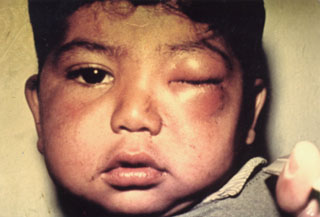American trypanosomiasis or Chagas disease

It is the result of the infection by Tripanosoma cruzi, which causes chronic cardiomyopathy, as well as megaesophagus and megacolon.
Etiology:
Trypanosomiasis cruzi is transmitted by various species of jungle bedbugs; These, at the same time they bite, deposit fecal stools that contain trypomastigotes in the skin. These infecting forms enter through the sting or pass through the mucous membranes. The parasites then invade macrophages at the entry site and become amastigotes, which multiply by binary fission and are released as trypomastigotes into the circulatory stream and the hystic spaces, from where they infect other cells.
It should be remembered that the disease can be transmitted by blood transfusions and contact with it or its derivatives. There are also reports of organ transplants. The transplacental pathway is involved.
Who transmits it?

In the chain of transmission of Chagas disease there is an intermediary, the vector insect, in America several species are known capable of transmitting the infection through their dejections; For example Triatoma infestam that like any insect, is oviparous. The female lays up to 200 elliptical, light-colored eggs of about 1mm long, which has a cap called the operculum. These eggs are deposited in the earth, in the cracks of the walls or in other places more or less hidden.
The incubation period depends on the ambient temperature, but it oscillates between 10 and 40 days. As the embryo develops, the eggs acquire a pink coloration and it is possible to see, by transparency, the eyes of the future vinchuca.
Some species are almost exclusively domestic. Therefore, the places that the vinchucas choose to live in can be estimated as follows: human dwellings, domestic and natural houses of animals (hens, dovecotes, rabbits, shelters protected from other animals, caves, nests, etc.). The insect takes refuge mainly in cracks in floors and walls, behind furniture or objects never changed, areas that are not periodically neat, under roofs or walls that offer cracks, especially between the "straw" of Quinchos and ranchos and in the solutions of continuity of adobe walls badly muddy or without revoking. In the houses, the presence of the vinchuca is relatively easy to discover: numerous yellowish white and black dejections dot the walls.
To live, the vinchuca feeds, from birth until it dies, exclusively with human blood or warm-blooded animals. As the bite is painless, the insect has peace of mind to suck for as long as it takes the amount of blood to fill up (which is about half a cubic centimeter each time). As it absorbs until it is full, it is unable to fly; So he walks slowly and awkwardly back to his usual refuge. The ingestion of these insects has a particularity: it is carried out only at night. In fact, the vinchucas only have dinner.
Epidemiology:
The disease is limited to the American continent and is distributed in rural areas of Mexico, Central and South America. It is also found in the United States and it is estimated that more than 100,000 migrants living in this country are chronically infected. In some parts of South America, Chagas' disease is the leading cause of death in children under 45 years of age.
Clinical picture:
For your better understanding, three phases of the disease will be indicated: acute, latent and chronic.
Acute phase:
Also called acute Chagas disease. It occurs mainly in children and is characterized peripherally. He has recurrent or continuous fever, lymphadenopathy, hepatosplenomegaly, and sometimes edema of the face and a morbilliform rash, called chagoma; Unilateral periocular and palpebral edema with conjunctivitis and preauricular adenopathy, which is called the Romagna sign; For others, the Romagna sign requires that the edema be in both eyes. A demonstrated myocarditis occurs in an electrical and clinical way. 5 or 10% of the patients with myocarditis and encephalitis die, but in a large proportion of cases the infection is practically asymptomatic.

Latent phase:
After the acute phase has passed, the patients may harbor the protozoan T. cruzi for a long time and remain asymptomatic; However, electrocardiographic signs of cardiac involvement are occasionally encountered due to systematic control or chance examination.
Chronic phase:
Usually, 1 or 2 years and sometimes decades later, the patient will present late symptoms of infection, which express damage to the heart and digestive tract especially. Symptoms and cardiac signs range from arrhythmias to congestive heart failure with right predominance. Degeneration of the conduction system results in Stokes-Adams syndrome and sudden cardiac death. Branch block is the most constant alteration in the ECG. Chronic lesions of the digestive tract mimic symptoms of esophageal achalasia and megacolon.
The first one presents as a dysphagia or regurgitation that sometimes causes a pulmonary infection by aspiration or severe malnutrition. Megacolon leads to severe constipation and intestinal volvulus. These chronic patients are immunosuppressed, which is capable of leading to a reactivation of the original infection with large parasitemia and transit for a second acute stage. Placental transmission of the condition leads to abortions and chronic neonatal disease, with high mortality rates and dead fetuses.
nice post friend
Have prevention
:O ese bicho mata? :O
si , con el pasar de los años si, pues causa enfermedades crónicas como la cardiomegalia.